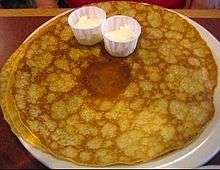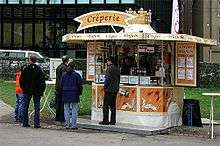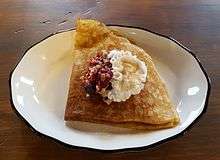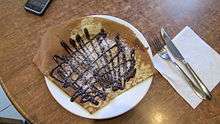Crêpe
|
A stack of crêpes | |
| Alternative names | Crepe |
|---|---|
| Type | Pancake |
| Place of origin |
|
| Serving temperature | Warm or Not |
| Main ingredients | Wheat flour or buckwheat flour, milk, eggs |
|
| |

A crêpe or crepe (/kreɪp/[1] or /krɛp/, French: [kʁɛp], Quebec French: [kʁaɪ̯p]) is a type of very thin pastry, usually made from wheat flour (crêpes de froment) or buckwheat flour (galettes). Crêpes belong to the general category of ancient Greek Tiganitai, from Greek tiganos (τίγανος), meaning "frying pan", which in English is literary translated to Pancakes [Athenaeus, Deipnosophistae, XIV, 645c; Galen, On the Properties of Foods, I, 3]. The French term, crêpe, derives from the Latin crispa, meaning tiganitai with "creases". While crêpes are often associated with Brittany, a region in the northwest of France, their consumption is widespread in France, Belgium, Canada, and many parts of Europe, North Africa, and the Southern Cone of South America. Crêpes are served with a variety of fillings, from the simplest with only sugar to flambéed crêpes Suzette or elaborate savoury galettes.
Preparation
Crêpes are made by pouring a wheat batter onto a frying pan or flat circular hot plate, often with a trace of butter or vegetable oil on the pan's surface. The batter is spread evenly over the cooking surface of the pan or plate either by tilting the pan or by distributing the batter with an offset spatula or trowel.[2][3] Cooking may take 30 to 60 seconds until the cooked side looks like the surface of the moon, then it is turned over to cook the other side; one can flip it in the air by swinging the pan.
Because the outside of the crêpe is more attractive, they are typically never served inside out.[4]
Sweet crêpes are generally made with wheat flour while savory crêpes are made with non-wheat flours such as buckwheat. Batters can also consist of other simple ingredients such as butter, milk, water, eggs, flour, salt, and sugar.[5]
Common savoury fillings for crêpes served for lunch or dinner are cheese, ham, and eggs, ratatouille, mushrooms, artichoke (in certain regions), and various meat products. The fillings are commonly added to the center of the crêpe and served with the edges partially folded over the center.
When sweet, they can be eaten as part of breakfast or as a dessert. They can be filled and topped with various sweet toppings, often including Nutella spread, preserves, sugar (granulated or powdered), maple syrup, golden syrup, lemon juice, whipped cream, fruit spreads, custard, and sliced soft fruits or confiture.
Types and special crêpes

Crêpes are especially popular throughout France. The common ingredients include flour, eggs, milk, butter, and a pinch of salt. Crêpes are usually of two types: sweet crêpes (crêpes sucrées) made with wheat flour and slightly sweetened; and savoury galettes (crêpes salées) made with buckwheat flour and unsweetened. The name "galette" came from the French word galet ("pebble") since the first gallettes were made on a large pebble heated in a fire. Batter made from buckwheat flour is gluten-free, which makes it possible for people who have a gluten allergy or intolerance to eat this type of crêpe. Mille crêpes is a French cake made of many crêpe layers. The word mille means "a thousand", implying the many layers of crêpe.[6] Another standard French and Belgian crêpe is the crêpe Suzette, a crêpe with lightly grated orange peel and liqueur (usually Grand Marnier) which is subsequently lit upon presentation.[7]
English pancakes are like wheat flour crêpes, and are served with golden syrup or lemon juice and sugar. Swedish pancakes, also called Nordic pancakes, are similar to the French crêpes. In some of the Nordic countries, they are served with jam or fruit, especially lingonberries (or the butter from that fruit) as a dessert with a variety of savory fillings. Traditional Swedish variations can be exotic. Beside the usual thin pancakes, called pannkakor in Swedish and räiskäle in Finnish, which resemble the French crêpes and, often served with whipped cream and jam, are traditionally eaten for lunch on Thursdays with pea soup, the Swedish cuisine (as well as the Finnish one) has plättar/lettu which resemble tiny English pancakes, and are fried several at a time in a special pan. Others resemble German pancakes but include fried pork in the batter (fläskpannkaka); these are baked in the oven. Potato pancakes called raggmunk contain shredded raw potato and may contain other vegetables (sometimes the pancake batter is omitted, producing rårakor). Raggmunk and rårakor are traditionally eaten with pork rinds and lingonberry jam. A special Swedish pancake is saffron pancake from Gotland, made with saffron and rice, baked in the oven. It is common to add lemon juice to the sugar for extra taste. The pancakes are often served after a soup. Another special "Swedish pancake" is the äggakaka (eggcake), also called skånsk äggakaka (scanian eggcake), it is almost like an ordinary Swedish pancake but it is a lot thicker and also a lot more difficult to make due to the risk of burning it. It is made in a frying pan and is about 1½ to 2 inches thick and is served with lingonberries and bacon. The Norwegian variety is commonly eaten for dinner, traditionally with bacon, jam (typically bilberry jam) or sugar.

The 49er flapjack is a sourdough crepe which is popular in the United States,[8] getting its name from the popularity of this style of pancake during the California Gold Rush. Because it is similar to a Swedish pancake the 49er is sometimes served with lingonberry sauce, although most often it is rolled up with butter and powdered sugar, or served open-faced and topped with maple syrup.
Cherry Kijafa Crêpes are also often common and are made with a traditional crêpe base, but filled with cherries simmered in a Kijafa wine sauce.[9]
Crêpe dentelle is a crispy biscuit made with a very thin layer of crêpe folded in a cigar shape and then baked. It is usually enjoyed with a hot drink during the goûter, in France.[10]
Crêperies

A crêperie may be a takeaway restaurant or stall, serving crêpes as a form of fast food or street food, or may be a more formal sit-down restaurant or café.[11]
Crêperies are typical of Brittany in France; however, crêperies can be found throughout France and in many other countries.
Because a crêpe may be served as both a main meal or a dessert, crêperies may be quite diverse in their selection and may offer other baked goods such as baguettes. They may also serve coffee, tea, buttermilk, and cider (a popular drink to accompany crêpes).[12]
In other countries


In Norwegian, crêpes are called Pannekake, in most German regions Pfannkuchen. In Swedish, a crêpe is called pannkaka in southern regions while being called "plättar" in the north, in Danish, pandekager ("pancake"), in Finnish a crêpe is called either ohukainen or lettu or räiskäle, in Dutch it is a pannenkoek or flensje, and in Afrikaans a pannekoek, which is usually served with cinnamon sugar. In the Spanish regions of Galicia and Asturias, they are traditionally served at carnivals. In Galicia, they're called filloas, and may also be made with pork blood instead of milk. In Asturias, they are called fayueles or frixuelos, and in Turkey, "Akıtma".
In areas of central Europe, formerly belonging to the Austro-Hungarian empire, there is a thin pancake comparable to a crêpe that in Austro-Bavarian is called Palatschinken; in Hungarian: palacsinta; and in Bosnian, Serbian, Bulgarian, Macedonian, Montenegrin, Czech, Croatian, and Slovene: palačinka; in Slovak: palacinka. In the Balkan region such as the countries of Albania, Bosnia, Croatia, Kosovo, Macedonia, Montenegro, and Serbia, palačinka or pallaçinka may be eaten with fruit jam, quark cheese, sugar, honey, or the hazelnut-chocolate cream Nutella, while there is also a breaded variant which is mostly filled with meat. Restaurants which are specialized in palačinci are called "Palačinkara" in the region. In Ashkenazi Jewish cuisine, there is a similar dish known as the blintz. The Oxford English Dictionary derives the German and Slavic words from the Hungarians palacsinta, which it derives from the Romanian plăcintă, which comes in turn from classical Latin placenta ("small flat cake"), even though the Romanian plăcintă is more similar to a pie, and the crêpes are actually called clătită.
Crêpes have also long been popular in Japan, with sweet and savoury varieties being sold at many small stands, usually called crêperies. In Argentina and Uruguay, they are called panqueques and are often eaten with dulce de leche. Various other French foods, such as crêpes, souffles, and quiche, have slowly made their way into North American cooking establishments.[13] Typically, these franchises stick to the traditional French method of making crêpes but they have also put their own spin on the crêpe with new types such as the hamburger and pizza crêpe. In Mexico, crêpes are known as crepas, and were introduced during the 19th century by the French [14][15] and are typically served either as a sweet dessert when filled with cajeta (similar to dulce de leche), or as a savoury dish when filled with Huitlacoche (corn smut), which is considered a delicacy.
Crêpes in European culture
During Russian celebration of Maslenitsa (Russian Butter Week), one of the most popular foods is blini, or crepes. Since crepes are made from butter, eggs and milk, they are allowed to be consumed during the celebration by the Orthodox church. There are endless combinations to the recipes and the execution of crepes. White flour can be replaced with buckwheat flour and milk can be switched for kefir. Also different oils can be added or substituted. Blini are served stocked with a piece of butter and topped with caviar, cheese, meat, potatoes, mushrooms, honey, berry jam or often a dollop of sour cream. The dish is supposed to represent the sun, since the holiday is about the beginning of the spring. [16]
In addition to crêperies and crêpe franchises, there are crêpe manufacturers that use modern equipment to produce crêpes in bulk.

Dishes with similar appearance, taste and preparation methods exist in other parts of the world as well. In South India, a crêpe made of fermented rice batter is called a dosa, which often has savoury fillings. In Western India, a crepe made of gram flour is called Pudlaa/Poodla, with the batter consisting of vegetables and spices. Another variety is called patibola and is sweet in taste due to milk, jaggery or sugar. The injera of Ethiopian/Eritrean/Somali/Yemeni cuisine is often described as a thick crêpe. Also in Somalia, Malawaḥ (Somali: Malawax) is very similar to a crêpe. It is mostly eaten at breakfast.
The names for thin crêpes in other parts of Europe are:
- Albanian: pallaçinka
- Asturian: frixuelo
- Bosnian: palačinka
- Breton: krampouezh
- Bulgarian: палачинка
- Cornish: krampoeth
- Croatian: palačinka
- Czech: palačinka
- Estonian: pannkook, ülepannikook
- Faroese: pannukaka
- Finnish: ohukainen, lätty, lettu or räiskäle
- Galician: filloas
- German: Palatschinke
- Greek: κρέπα (krépa)
- Hungarian: palacsinta
- Icelandic: pönnukaka
- Kazakh: құймақ (quymaq)
- Latvian: pankūka
- Lithuanian: lietiniai blynai
- Polish: naleśniki
- Portuguese: crepe
- Romanian: clătită
- Russian: блины (bliny)
- Serbian: палачинка
- Slovak: palacinka
- Slovene: palačinka
- Spanish: crepes
- Turkish: krep, akıtma
- Ukrainian: млинці, налисники (mlyntsi, nalysnyky)
- Welsh: cramwyth
In culture
The crêpe was born as an accident, created by fourteen-year-old waiter Henri Charpentier in 1895 at the Maitre at Monte Carlo’s Café de Paris. He was preparing a dessert for the Prince of Wales and describes the creation of the desert in a published book about his life. He states that it was an accident that the pastry had burned and Charpentier tasted it hoping it would be good enough to serve, since there wasn't enough time to create a new dish. Charpentier describes the creation of the crêpe with, "Thus was born and baptized this confection, one taste of which, I really believe, would reform a cannibal into a civilized gentleman." It was served to the prince who enjoyed it so much that the following day he sent its creator a panama hat, a cane, and a jeweled ring.[17]
In France, crêpes are traditionally served on Candlemas (La Chandeleur), 2 February. This day was originally Virgin Mary's Blessing Day but became known in France as "Le Jour des Crêpes" (literally translated "The Day of the Crêpes", but sometimes given colloquially as "Avec Crêpe Day", "National Crêpe Day", or "day of the Crêpe "), referring to the tradition of offering crêpes. The belief was that if you could catch the crêpe with a frying pan after tossing it in the air with your right hand and holding a gold coin in your left hand, you would become rich that year.[18][19] The roundness, and golden color from being fried in butter, of the crêpe resembles the sun and its rays. This symbolism also applies to the coin held in the person's hand.[20]
See also
- Bánh xèo
- Blintz
- Crêpe bretonne
- Crepe maker, crepe cooking device
- Dosa
- Galette, another kind of Breton pancake, also from Brittany, France
- Injera
- Jianbing, a traditional Chinese street food similar to crepe
- Kouign amann, another Breton delicacy
- Krampouz, crepe maker manufacturer, also from Brittany, France
- List of brunch foods
- List of pancakes
- Maslenitsa
- Memiljeon
- Palatschinken
- Pancake Day
- Popiah, Chinese roll wrapped in a thin crepe made by "wiping" dough on a hot plate
- Ploye, a buckwheat pancake originating from Acadian cuisine of Canada
- Poffertjes, small ball-shaped pancake, particularly popular in the Netherlands
- Roti prata
- Sope
- Swedish pancake
- Tava
References
- ↑ Longman Pronunciation Dictionary. 3rd Ed. 2008.
Merriam-Webster Dictionary - ↑ Pellegrinelli, Carroll. "Desserts / Baking-Basic Crepe Recipe". About.com. Retrieved 17 May 2012.
- ↑ Crepe Tools.
- ↑ "The Art of the Crepe; If a crepe is like a blank canvas, ready to be filled with anything you can think of, then the secret to making a good crepe is to be artistic." Morning Star (Wilmington, NC). (19 September 2001 , Wednesday ): LexisNexis Academic.
- ↑ "Wrap it up in a crêpe; Thin pancakes work in savoury or sweet dishes." Times Colonist (Victoria, British Columbia). (24 April 2013 Wednesday) LexisNexis Academic.
- ↑ Hesser, Amanda (15 May 2005). "The Way We Eat: Building a Modern, Multistoried Dessert". The New York Times.
- ↑ Courtine, Robert J. (1984), Larousse gastronomique (French edition), Paris: Librairie Larousse.
- ↑ http://articles.latimes.com/1995-03-16/news/ol-43368_1_original-pancake-house
- ↑ Pancake House (2007). "Cherry Kijafa Crepes"; retrieved from http://www.originalpancakehouse.com/phm_crepes2.html.
- ↑ "lace crepes". Retrieved 4 December 2012.
- ↑ "La Creperie Cafe". Retrieved 3 December 2012.
- ↑ "La Creperie Key West". Retrieved 3 December 2012.
- ↑ Benenson, R. (1984). Dining in America. Editorial research reports 1984 (Vol. I). Washington, DC: CQ Press.
- ↑ Fernández-del-Villar, Miguel Angel and Ruiz-Naufal, Víctor M., Mesa Mexicana (1993), Fundación Cultural Bancomer, ISBN 9789686084948
- ↑ http://www.mexconnect.com/articles/2139-the-french-influence-on-mexican-cooking-la-comida-afrancescada
- ↑ http://eurokulture.missouri.edu/buttery-crepes-of-deliciousness-and-other-stuff/
- ↑ "Recipe - A Delicious Mistake". Nobility and Analogous Traditional Elites. 2012-07-26. Retrieved 2017-07-02.
- ↑ Clay, Xanthe (17 February 2007). "With a flame in your art". The Daily Telegraph. London. Retrieved 25 April 2008.
- ↑ Redmond, Barbara (30 January 2012). La Chandeleur – Le Jour des Crêpes. Retrieved on 28 February 2012 from http://awomansparis.wordpress.com/2012/01/30/la-chandeleur-le-jour-des-crepes/.
- ↑ Sokolov, Raymond. "Sun food." Natural History May 1993: 82. Academic Search Complete.
- 19. Life A La Henri – Being The Memories of Henri Charpentier, by Henri Charpentier and Boyden Sparkes, The Modern Library, New York, 2001 Paperback Edition. Originally published in 1934 by Simon & Schuster, Inc.
External links
-
 Media related to Crêpe at Wikimedia Commons
Media related to Crêpe at Wikimedia Commons -
 The dictionary definition of crêpe at Wiktionary
The dictionary definition of crêpe at Wiktionary -
 Crêpe at Wikibook Cookbooks
Crêpe at Wikibook Cookbooks

